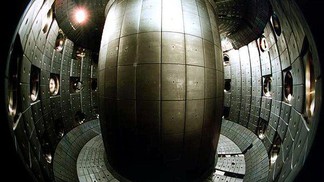Jan 16, 2012
 |
| Confined chamber for the plasma © EPFL |
Using a heating system, physicists have succeeded for the first time in preventing the development of instabilities in an efficient alternative way relevant to a future nuclear fusion reactor. It’s an important step forward in the effort to build the future ITER reactor.
Scientists have achieved a milestone: they have managed to stop the growth of instabilities inside a nuclear fusion reactor. How? Here’s a look at this energy source, which despite being challenging to control, is nevertheless extremely promising.
Nuclear fusion is an attempt to reproduce the energy of the Sun in an Earth-based reactor system. When gas is heated to several million degrees, it becomes plasma. Sometimes in the plasma, an instability will appear and grow large enough to perturb the plasma, making it vibrate despite the presence of the magnetic field in which it is contained. If the plasma touches the walls of the reactor, it will cool rapidly and create large electromagnetic forces within the structure of the machine.
The challenge is to reduce the instabilities deep within in the interior of the plasma so that they don’t amplify, while at the same time allowing the reactor to continue to function normally. Thus it is necessary to work within the specific configuration of these fusion reactors, where the plasma is strongly confined by a magnetic field. By adjusting an antenna that emits electromagnetic radiation, Jonathan Graves and his colleagues from EPFL’s Center for Research in Plasma Physics were able to quench the instabilities when they appear, in the precise region where they are forming, and without perturbing the rest of the installation.
From theory to practice
The physicists first conducted simulations to verify the extent to which specific radiation frequencies and locations of application would suppress the growth of instabilities. Then they carried out tests to confirm their calculations. The beauty of their approach is that they were able to use antennas that are used as part of the system to heat the plasma, and that are already present in the Joint European Torus (JET), the largest reactor currently in use. Surprisingly, the simulations and the tests showed that heating and instability suppression can be combined, by aiming the radiation slightly off-center in the plasma.
The next step will be to add a detector system that will make it possible to neutralize instabilities in real time over longer time periods. These improvements can then be implemented in the ITER fusion reactor, currently in development in Southern France.
Source: École polytechnique fédérale de Lausanne (EPFL)
Additional Information:
- "Control of magnetohydrodynamic stability by phase space engineering of energetic ions in tokamak plasmas", J.P. Graves, I.T. Chapman, S. Coda, M. Lennholm, M. Albergante & M. Jucker, Nature Commun. *3*, 624 (2012). DOI: 10.1038/ncomms1622
1 comments:
I like the helpful info you provide in your articles. I will bookmark your weblog and check again here frequently. I'm quite certain I will learn plenty of new stuff right here! Best of luck for the next!
CZech 12 x 12 Foot Camo Netting
Post a Comment